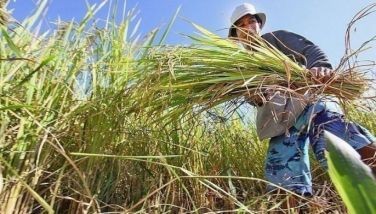126 superior crop varieties in 30 yrs
June 12, 2005 | 12:00am
Pagasa. 911. Sinta. Maria Makiling. Celebrity Stars.
No, we are not writing about the weather. Or rescue operations, much more terrorism. Neither are we dealing with love. Or fairies, enchantresses, and beautiful people.
The words cited are but among the 126 superior varieties of 33 crops bred over he past three decades by the UP Los Baños-Institute of Plant Breeding (UPLB-IPB). During the period, IPB also registered 72 crops, mostly vegetables, fruit trees, and ornamentals, with the IPB Germplasm Registration and Release Office (GRRO).
These significant accomplishments of the institute were highlighted last June 3 at a program marking the celebration of IPB’s 30th anniversary.
As IPB’s current director, Dr. Desiree Hautea, said: "The institute in its 30 years of glory has developed and bred outstanding varieties of major agricultural crops such as corn, peanut, mungbean, sweet potato, cassava, tomato, eggpalnt, papaya, and many others. During this special day we will recognize the contributions of our scientists and the varieties that they have developed which has brought fame and honor to the institute."
The Pagasa Series of 12 mungbean varieties, bred by scientists led by IPB’s second director, Dr. Ricardo Lantican, are now widely grown in the Philippines and in other neighboring countries. These were also used as parental sources in Taiwan and South Korea.
The many IPB crop varieties can be aptly called products of the scientists "labor of love".
A remarkable example is Sinta, the first Philippine papaya hybrid with moderate tolerance to the dread papaya ringspot virus (PRSV), which has decimated papaya farms in Luzon and Visayas over the past two decades.
Bred by IPB researchers led by the institute’s seventh director, Dr. Violeta Villegas, Sinta is now reviving the country’s papaya industry from the ravages of PRSV.
Maria Makiling is the creamy white variety of Mussaendas (ornamental plants), whose beeding was initiated in collaboration with the UPLB College of Agriculture-Department of Horticulture.
Diwata is the pure white Mussaenda released together with Lakambini (red and pink), Paraluman (rose and pink), and Ming Ramos (named after the former First Lady).
Celebrity Stars are Hibiscus (gumamela) hybrids named after movie superstars. Other IPB-bred gumamela now immortalize Filipino heroines in the revolution and Filipino women of science and the arts.
The other crops bred by IPB have also been interestingly named.
• DLU Pearl Sweet, named after the late National Scientist and UPLB-CA dean Dr. Dioscoro L. Umali, is the country’s first double mutant corn variety with excellent eating quality. It is now grown in 15 provinces.
• EQJ White, the first white full-season three-way cross hybrid, was christened after Dr. Emil Q. Javier, IPB’s founding director who later became UPLB chancellor an UP president.
• Tiwala 6 is the most widely planted soybean in Cagayan Valley and still unsurpassed in performance. Tiwala 10 is recommended for Mindanao.
• Biyaya is the tag name of peanut varieties that are high-yielding and resistant to peanut pests and diseases and acceptable as boiling type groundnut.
• Ara and Assunta (remember those sexy movie stars?) are the first tomato hybrids while Rica and Rosanna (again, those voluptuous actresses) are also high-yielding open-pollinated varieties.
These are but among the prolific, good-quality, and sturdy varieties that are now widely planted by Filipino and other Southeast Asian farmers.
By the way, others who had served as IPB director included R. Ruben Villareal, Dr. Eufemio Rasco Jr., and Dr. Randy Hautea.
Summing up, IPB has impacted national and international programs in agriculture, contributing to the economy, nutrition, and food security of nations.
No, we are not writing about the weather. Or rescue operations, much more terrorism. Neither are we dealing with love. Or fairies, enchantresses, and beautiful people.
The words cited are but among the 126 superior varieties of 33 crops bred over he past three decades by the UP Los Baños-Institute of Plant Breeding (UPLB-IPB). During the period, IPB also registered 72 crops, mostly vegetables, fruit trees, and ornamentals, with the IPB Germplasm Registration and Release Office (GRRO).
These significant accomplishments of the institute were highlighted last June 3 at a program marking the celebration of IPB’s 30th anniversary.
As IPB’s current director, Dr. Desiree Hautea, said: "The institute in its 30 years of glory has developed and bred outstanding varieties of major agricultural crops such as corn, peanut, mungbean, sweet potato, cassava, tomato, eggpalnt, papaya, and many others. During this special day we will recognize the contributions of our scientists and the varieties that they have developed which has brought fame and honor to the institute."
The Pagasa Series of 12 mungbean varieties, bred by scientists led by IPB’s second director, Dr. Ricardo Lantican, are now widely grown in the Philippines and in other neighboring countries. These were also used as parental sources in Taiwan and South Korea.
The many IPB crop varieties can be aptly called products of the scientists "labor of love".
A remarkable example is Sinta, the first Philippine papaya hybrid with moderate tolerance to the dread papaya ringspot virus (PRSV), which has decimated papaya farms in Luzon and Visayas over the past two decades.
Bred by IPB researchers led by the institute’s seventh director, Dr. Violeta Villegas, Sinta is now reviving the country’s papaya industry from the ravages of PRSV.
Maria Makiling is the creamy white variety of Mussaendas (ornamental plants), whose beeding was initiated in collaboration with the UPLB College of Agriculture-Department of Horticulture.
Diwata is the pure white Mussaenda released together with Lakambini (red and pink), Paraluman (rose and pink), and Ming Ramos (named after the former First Lady).
Celebrity Stars are Hibiscus (gumamela) hybrids named after movie superstars. Other IPB-bred gumamela now immortalize Filipino heroines in the revolution and Filipino women of science and the arts.
The other crops bred by IPB have also been interestingly named.
• DLU Pearl Sweet, named after the late National Scientist and UPLB-CA dean Dr. Dioscoro L. Umali, is the country’s first double mutant corn variety with excellent eating quality. It is now grown in 15 provinces.
• EQJ White, the first white full-season three-way cross hybrid, was christened after Dr. Emil Q. Javier, IPB’s founding director who later became UPLB chancellor an UP president.
• Tiwala 6 is the most widely planted soybean in Cagayan Valley and still unsurpassed in performance. Tiwala 10 is recommended for Mindanao.
• Biyaya is the tag name of peanut varieties that are high-yielding and resistant to peanut pests and diseases and acceptable as boiling type groundnut.
• Ara and Assunta (remember those sexy movie stars?) are the first tomato hybrids while Rica and Rosanna (again, those voluptuous actresses) are also high-yielding open-pollinated varieties.
These are but among the prolific, good-quality, and sturdy varieties that are now widely planted by Filipino and other Southeast Asian farmers.
By the way, others who had served as IPB director included R. Ruben Villareal, Dr. Eufemio Rasco Jr., and Dr. Randy Hautea.
Summing up, IPB has impacted national and international programs in agriculture, contributing to the economy, nutrition, and food security of nations.
BrandSpace Articles
<
>
- Latest
Latest
Latest
November 9, 2024 - 3:43pm
By E.H. Edejer | November 9, 2024 - 3:43pm
June 9, 2024 - 5:55pm
By Alberto Peña | June 9, 2024 - 5:55pm
May 24, 2024 - 10:00am
May 24, 2024 - 10:00am
May 14, 2024 - 3:43pm
By Ian Laqui | May 14, 2024 - 3:43pm
April 10, 2024 - 5:12pm
By Ian Laqui | April 10, 2024 - 5:12pm
Recommended



























